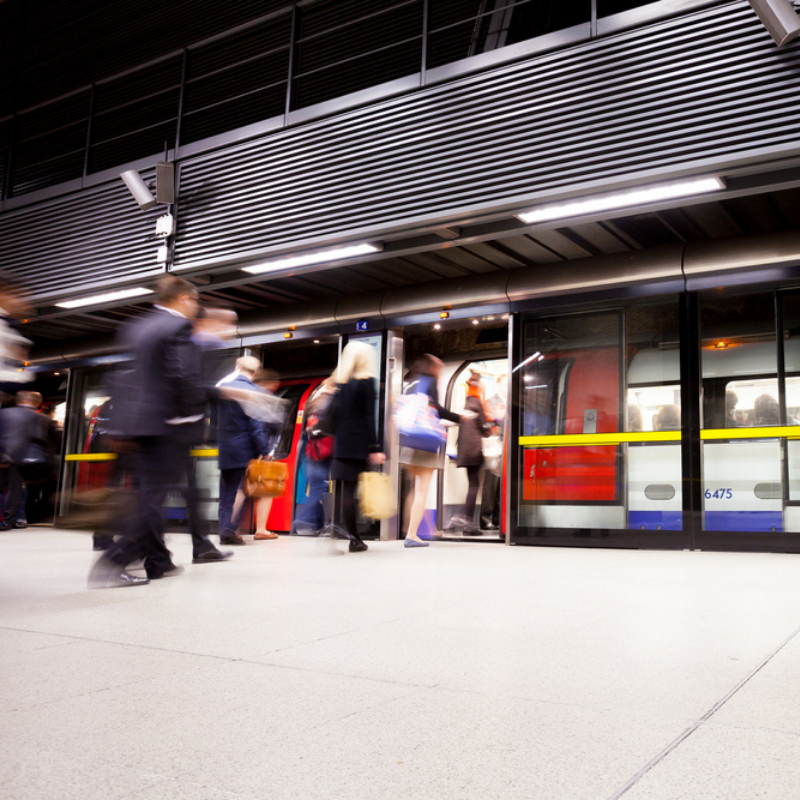The engineering challenge
This is a massive project, not least because the Tube is one of the oldest underground rail systems in the world. Uninterrupted 4G mobile coverage has already been introduced on the eastern half of the Jubilee line – but it will now be expanded to ticket halls, platforms and tunnels on the underground stations of the Tube network over the next four years, with all stations and tunnels due to have 5G ready mobile coverage by the end of 2024.
Once fully delivered, Boldyn will have built nine data centres across the city and installed more than 1,000 kilometres of cabling within tunnels and stations overall. It is essential that this is delivered while ensuring minimal inconvenience to passengers. Boldyn’s design minimises the disruption of digging up roads in order to build the network, with the majority of work taking place in existing tunnels.
However, transport systems in major cities often only stop for a few hours each night, if at all. This means most of the work will be carried out during maintenance hours, in short bursts of two to three hours, so that travel can continue seamlessly during the day. To fit the work into such a short timeslot, our engineers will swap their traditional, bulky tools for lighter, modern versions. Boldyn will also be using innovative methods, such as remote equipment monitoring, to enable improved efficiency and to deliver the project on time and on budget.
Working within confined, complex, and hard to manage spaces, like the London Underground, will always present challenges. Due to the sensitivity and complexity of the technologies used, extra care will be taken during installation to resist the heat, damp and dust found in this hostile underground environment, as well as making sure trains do not strike newly installed equipment. The solution to all of this is highly detailed planning. From using 3D visualisation to show how installation will work and the best locations for equipment, to carefully installing the right equipment enclosures and durable, dust-proof network components.
It is also for these reasons that a neutral host solution – one that is designed, built, maintained and innovated by a neutral third party – is the only logistically viable route to enable connectivity on the London Underground. The physical confines of the environment mean that infrastructure must be created which multiple operators can share, benefiting all parties as the technology is provided at a much lower cost for each operator, the connections experienced by the end-user are improved, and TfL has a simplified engagement with a single infrastructure provider.
The scale of the project means it will require 5-million-man hours of work over the next four years. To meet this, Boldyn’s workforce is expanding, creating new employment opportunities in London across numerous disciplines. A combined team of up to 600 people will be working on this project over the next four years. BAI will also continue to partner with charities and provide educational opportunities in communities across the capital, as well as play our part in creating a lasting legacy for London by expanding BAI’s apprenticeship programme.
Boldyn’s neutral host model means all mobile and fixed operators in London will be able to use the infrastructure. Making it available to their customers to enhance their experience, in their homes, offices or as they travel across the city.
Over the course of the 20-year contract, Boldyn anticipates investing in excess of £1 billion to support the Connected London vision to ensure that London is the best-connected city in Europe, where affordable full fibre connections are available to all homes and businesses. Boldyn’s expert team will use the transport system to establish a backbone of connectivity across the capital with a city-wide integrated communications network. A new high-capacity fibre network will leverage the power of 5G and fast-track London’s transformation into a truly smart city.
An advanced backbone of connectivity
The city-wide communications network will bring together a range of capabilities supported by a backbone of new digital connectivity for the capital. The new digital fabric for London will offer five significant digital services:
High speed mobile services will solve one of Europe’s largest ‘not spots’ and provide continuous, uninterrupted cellular mobile coverage in all ticket halls, on platforms and in tunnels across the Tube network. It is highly flexible and capable of carrying 2G, 3G, 4G, and 5G from any mobile network operator, and beyond with two significant future upgrades envisioned for 6G and 7G.
The Emergency Services Network (ESN), the government’s chosen option to replace the current Airwave system for 107 police, fire and ambulance services in England, Scotland, and Wales to use for communications between control rooms and the field. The city-wide communications network will bring together a range of capabilities supported by a backbone of new digital connectivity for the capital. The new digital fabric for London will offer five significant digital services: This integrated, multi-carrier, multi-service network will span the entirety of central London. Mobile cellular coverage will be provided in the ticket halls and platforms of 137 below ground stations, which we expect will require an initial deployment of 5,500 low power radio units. Coverage will continue through 210 kms of tunnel sections, requiring the laying of 770kms of leaky feeder cable. These special cables provide mobile signal coverage underground and we expect to deploy 1,000 high power radios to boost the signal in the longer tunnels. The underground stations are linked by 217 tunnel sections in total, requiring the production of 217 individual radio designs, in addition to the 137 designs for the stations. 220 kms of new fibre will be laid that will interconnect above ground at the 137 POPs that will need to be constructed. The latest technology will be deployed as part of the network build out. This includes developments such as digital DAS and the latest generation of fibre network switches and IP routers.
A new fibre backbone will be laid, beginning with 220 kms of cable stretching across London and coming above ground at stations to provide up to 137 points of presence (POPs) throughout London.
A small cell and Internet of Things (IoT) network is envisioned, using TFL’s streetscape assets such as lampposts, traffic lights, front of stations, and bus shelters, to deploy 5G small cells that will help mobile networks cope with the large data demands of customers in dense urban areas. Also enabling scale deployment of IoT sensors to better manage smart applications. 5. The existing Wi-Fi network will also be upgraded, then integrated and maintained.
This integrated, multi-carrier, multi-service network will span the entirety of central London. Mobile cellular coverage will be provided in the ticket halls and platforms of 137 below ground stations, which we expect will require an initial deployment of 5,500 low power radio units. Coverage will continue through 210 kms of tunnel sections, requiring the laying of 770kms of leaky feeder cable. These special cables provide mobile signal coverage underground and we expect to deploy 1,000 high power radios to boost the signal in the longer tunnels. The underground stations are linked by 217 tunnel sections in total, requiring the production of 217 individual radio designs, in addition to the 137 designs for the stations. 220 kms of new fibre will be laid that will interconnect above ground at the 137 POPs that will need to be constructed. The latest technology will be deployed as part of the network build out. This includes developments such as digital DAS and the latest generation of fibre network switches and IP routers.
Benefits to passengers
Delivering full mobile device coverage across the London Underground for the first time will be a critical improvement for the over five million passengers a day that the network served pre-pandemic. The ability to access full mobile phone coverage across the London Underground will help to improve the experience for all passengers, boost productivity, and improve network safety and reliability.
Passengers will be able to catch up on or get ahead of their work, access online shopping, make reservations, stream content, and access social media while travelling, making a 40-minute journey feel more like 20 minutes. Connectivity on the go also means that people can plan their journey, tick items off their ‘to do’ list, and free up non-travel time, having a positive impact on wellbeing. More broadly, it will open further opportunities to change working hours and location, as people can check and send emails on their commute. Ultimately helping the transport authority to support London’s post-COVID recovery as travel resumes with more flexible working patterns.
Fundamentally, passengers want safe, connected, and reliable services. Boldyn surveyed nearly 500 people who regularly use the London Underground as part of the 2021 Connectivity Outlook report. The survey asked them how they saw the state of transport, connectivity, and their role in the city’s future. Expectations went beyond a network that simply transports people from A to B, with reliability (77%) and safety (76%) cited as the most important features of public transport. Continuous connectivity, enabled by Boldyn’s infrastructure, will help to reduce overcrowding and manage station flow, while safety is improved by real-time information and reliable ‘from anywhere’ communications.
Benefits to mobile and fixed operators
Boldyn will build and operate a neutral host solution with a single 4G-enabled and 5G-ready communications network that all fixed and mobile operators can share – a far more efficient, cost effective and environmentally friendly approach than each one installing and operating their own network. Boldyn’s infrastructure is future-ready and can incorporate new technologies as and when they become available. The first phase of the project will see the rollout of modern multi-carrier infrastructure. This will allow mobile operators to immediately provide continuous 4G coverage to their customers across the London Underground and will also be 5G ready, allowing for a seamless transition in the future. Establishing a high-capacity fibre backbone throughout London, bringing fibre-optic cables underneath homes and buildings, will also enable fixed providers to provide fibre backhaul throughout the city. Boldyn is building networks that cater for what passengers want, both now and in the future. The demand for connectivity is only going to grow and, with this being a 20-year concession, BAI is planning to be catering beyond 5G for whatever technologies come next. There is an extra G roughly every 7 years in the industry, so there may be 7G by the time the concession is finished. BAI is building the network with scalability in mind to be able to make those changes. As part of the project, BAI is working with operators to ensure their requirements are part of the design and are already ensuring there is additional cabling in place to account for capacity increases and service upgrades.
The most advanced network of its kind
Once this programme is completed, the London Underground will be home to the most advanced integrated multi-service network of its kind anywhere in the world. By providing high-speed mobile coverage across the capital and supporting the capital’s transformation into a truly smart city, Boldyn will ensure that London leapfrogs other major cities in terms of connectivity and remains the most attractive place for investment, a place where innovators can thrive. By delivering seamless, 5G ready connectivity, Boldyn will provide social benefits over the next two decades. Creating the smart communities of the future that will enable people to move around London more smartly, safely, and securely
Connected London: creating the smart communities of the future
Neutral host infrastructure has a huge role to play in supporting ambitions for the capital to be the best-connected city in Europe. Developing smart communities and, ultimately, a smart city underpinned by a connected backbone of macro cells, small cells and movable sources.
London’s Tube tunnels will be used to provide full connectivity across the city, bringing fibre directly into London’s neighbourhoods, creating new opportunities to serve homes and businesses with gigabit-capable speeds and supporting digital inclusion. According to the Mayor of London, only around 11% of the capital’s buildings can access full fibre connectivity currently. Enabling small and medium-sized enterprises (SMEs) to have affordable gigabit-capable connections could see productivity increases of between 7% and 10%. Boldyn’s long-term partnership will deliver the foundation needed for London’s businesses to be fully connected.
5G, IoT and data analytics will also unlock new economic and social opportunities for communities across London. The network can connect to small cells in buildings and street assets to increase mobile coverage through small mobile transmitters, as well as leveraging the power of 5G and IoT to deliver city-wide improvements and future growth.
Boldyn will also help to create a safer, smarter London by building and operating critical communications infrastructure that will support the police, fire, and ambulance services.
For public transport, the insights derived from IoT sensors and Wi-Fi data can provide a real-time view of current conditions and improve services.
Enabling operators and public bodies to respond flexibly to customer needs and even anticipate them. Fitting additional sensors to tracks, vehicles, and other assets will enhance these capabilities and enable more smart applications like vehicle health monitoring, predictive maintenance, and overcrowding management.
Going further to connect camera data, ticketing systems, and digital signage will allow even more granular data feeds that improve safety, reliability, and end user experience. Beyond this, Boldyn has ambitions to support London in becoming a greener and cleaner city. Not only does providing passengers with uninterrupted connectivity have a role to play in helping the UK reach its ambitious net zero goals by encouraging people to opt for public transport. But air quality sensors can also be mounted to existing infrastructure, such as lampposts, allowing IoT data to be collected continuously at a hyper-local level. Once an air quality sensor network is in place, authorities will be able to use the data to make decisions about how to best manage footfall and vehicle numbers, and their impact on air quality levels.
Communities of all sizes, including individual neighbourhoods or networks within London, will benefit from Boldyn’s technology enhancing public services, reducing costs, and improving quality of life for residents. Creating smart communities is about having the right infrastructure in the right place to allow individuals, businesses and their local areas to thrive, and ultimately laying the foundations for London to become a truly smart city.
*Transport for London (TfL) awarded BAI Communications the contract in 2021. BAI Communications is now Boldyn Networks in the Northern Hemisphere.








